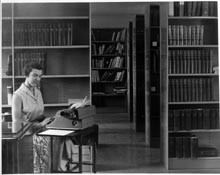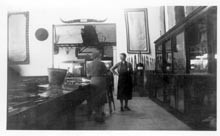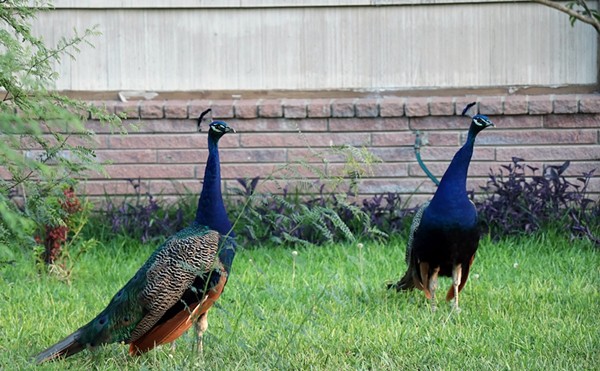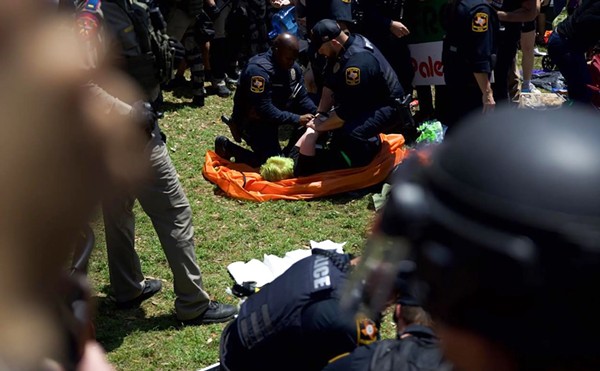For decades, Witte staffers like Contreras have experienced weird phenomena, from spectral figures to shuffled papers on their desks. Paranormal investigators have recorded strange interference on videotapes, unusual electromagnetic fields, and odd drops in temperature.
The Witte has all the makings of a supernatural hot spot, from the Egyptian mummy display on the second floor, to the historic houses moved and rebuilt behind the museum, to its very location — once a Native American campsite.
But most staffers seem to believe the Witte ghost's origins lie closer to home: Some think that the museum's trailblazing (and deceased) founder remains on the grounds, making sure things are running the way she likes them.
It's midnight at the Witte. The galleries sit quiet and bright and empty. Juan Contreras, carrying a large blue flashlight, escorts a visitor up the stairs to the Piper Memorial Wing. At night, the overhead lighting ends at the entrance to the Texas By Candlelight displays, and the gallery hosting the temporary Squeezebox exhibit sits in pitch darkness.
Contreras is a five-year veteran at the Witte. Before that, he served four years in the Air Force. He's calm and soft-spoken, and seems to accept any strange happenings at the museum as just another part of his job.
| Most activity takes place in the former library, now the Witte's glass storage. |
"If you don't have a flashlight, this place can be pretty intimidating," Contreras says, as he passes through the exhibits. He points out mirrors that reflect the feet of passersby, which to unwary visitors can look as if something else is moving at the periphery of their vision.
In the gallery beyond, the beam from his light sweeps across framed photographs and gallery walls. Glimpses of white dresses hanging in an adjacent gallery seem like something more sinister. "We actually provide (officers) with flashlights," Contreras says. "And I can tell you that the guys usually tell you when their batteries are running out."
As fellow security officer Ruth Boyer waits at the entrance of the gallery, Contreras sits down on a bench and switches off his flashlight. For more than a minute, he waits in pitch darkness as the air conditioning hums softly.
"Did you feel anything?" he asks at last. "I got a vibe that came from this corner," he says, turning on the flashlight and shining it toward the back of the gallery. "It's something that came from right there." Boyer, in the doorway, agrees: She got the sense that someone was standing in the same corner.
Contreras directs his flashlight at the track lighting on the ceiling. "I've actually seen this track turn on," he says. "The way to turn all these lights on is actually on the first floor. Usually when I see this on, I'm going to run down to the first floor and check. It's not a very big campus, so within 20 minutes you're bound to find somebody who's here."
He walks to the opposite wing of the museum, past the mummy in its glass case, and hits the call switch on the museum's old-fashioned elevator. The car is eerie and yellow-lit inside, a little too bright. When the doors close, the entire car lurches with a jarring bang, then begins to descend.
"When I was posted at the front desk, I would hear the elevator just open the doors," Contreras says. "If you're sitting at the front desk, and you see these bad boys open, yeah, you're going to be kind of spooked." Other times, he would hear the elevator suddenly begin to climb to the second floor. "So I'd come running up the stairs to see (who was in it), and nobody was there."
Contreras has never actually seen a ghost during his shifts at the Witte. "If I actually do see something, I think my first reaction's going to be, 'Hey, how's it going?'" he jokes. He says he tries to treat any spirit haunting the galleries with friendliness and respect; if he gets "a bad vibe" while entering a gallery, he'll announce himself and explain why he's there.
"I like to believe that whatever spirit was here was looking out for me," he says, "helping me to do my job correctly."
Unlike Contreras, Melea Williams only spent one night guarding the Witte Museum. One night, she said, was enough.
Williams, a former guard for Wackenhut Security Services, said she usually guarded the San Antonio Museum of Art. One night in 1987, she filled in at the Witte.
| Ellen Quillen, right, in the old exhibition hallway of the Witte. Does she still wander the halls? |
"I was violently attacked in the elevator while making rounds," she recounted. "I was pushed down so hard to the floor that when the elevator door opened, I had to crawl out of the elevator on my hands and knees. I literally could not move until the elevator door opened.
"Afterward, I said, 'I am a new guard, so please don't get angry. I won't bother anything and just need to do my job,'" Williams said.
"The rest of the night went very smoothly, minus the light being turned on in a storage/catalog area," she said. "The area is on the first floor and (was) the last door on the right and was supposed to be locked — which I didn't know at the time.
"The relief guard had found the door unlocked," Williams recalled. "He smiled at me and said, 'Had a rough night?'"
Williams' story doesn't surprise local writer and producer Laura Dietrich, whom the Witte hired in 1999 to write a play on the life of its founder, Ellen Schulz Quillin.
"She seemed to get along a lot better with men than with women," Dietrich said of Quillin. "She seems to have been an extremely focused woman, and someone who didn't delegate," she added, choosing her words carefully. "She was a little bit of a ballbuster."
Dietrich researched Quillin's life extensively, interviewing museum staffers and people who knew Quillin for the play, A Gallery of Ghosts, which the Witte stages to introduce young visitors to the museum's colorful history.
In Dietrich's play, Quillin recounts for the audience her early life in Michigan as Ellen Schulz, the tomboy in a family of six girls. She abandoned her scientific studies at the University of Michigan to accompany her tuberculosis-wracked sister to San Antonio in 1916. Here, Schulz took a job teaching botany at Main Avenue High School.
After her sister's death, Schulz took an interest in a collection of natural artifacts that Houston businessman H.P. Attwater had put up for sale. She and her students raised $5,000 to buy the collection, and displayed portions of it in two empty classrooms beginning in 1923. The collection quickly outgrew its existing home, and Schulz again launched herself into fundraisers to give San Antonio a proper museum.
Schulz became a frequent visitor to City Hall. She managed to persuade Mayor John W. Tobin to donate land for the museum by promising him that she wouldn't get married — and thus, Tobin feared, distracted — until the museum was a success.
A sympathetic city clerk, to whom Schulz had appealed for fundraising permits, passed her idea along to one of his poker buddies — quiet, respectable local businessman Alfred Witte. Upon Witte's death in 1925, Schulz learned he had bequeathed $65,000 toward the construction of a science and history museum in Brackenridge Park.
The museum opened its doors October 8, 1926, with Schulz as its director. After a year, Tobin finally gave his blessing for Ellen Schulz to end her scandalously long engagement and marry Roy Quillin. Though the Great Depression nearly killed the museum in its infancy, Ellen Quillin opened a Reptile Garden nearby, and subsidized the Witte with profits from a pit full of live rattlesnakes and alligators.
Quillin served at the museum for 34 years, until she was forced into retirement. She left her post as director the day before Halloween, 1960, but kept an office at the museum as director emeritus for nearly 10 more years. Defying doctors' orders, she remained active at the museum until her death on May 5, 1970, at somewhere around eighty years of age.
"People who work there seem to take it for granted" that Quillin haunts the grounds, Dietrich said. "It probably comes from the fact that she was so single-handedly responsible for the creation of that museum. She seems to have been so much a part of that building and its day-to-day running, for so long."
For Rebecca Huffstutler, the Witte's curator of archives, working in an apparently haunted museum "makes the job a little bit more interesting."
Huffstutler, a Witte employee since 1990, has heard plenty of stories about movements and footsteps in otherwise empty rooms. The museum's glass storage room — once Quillin's office — is a center of activity. "We've heard pottery being moved across the shelves inside," she said. "That's always fun."
Three years ago, Huffstutler compiled her own stories and those of other employees for a report on spectral activity at the museum. On February 26, 1999, ghost hunters from the Institute of Paranormal Investigations spent the night at the museum to mark the opening of the Gallery of Ghosts presentation. The investigators brought electromagnetic field detectors, cameras with regular and infrared film, video cameras, audio recorders, and sound spectrum analyzers.
According to the report by Institute member Michael John Weaver, during a Gallery of Ghosts reading in one of the museum's hallways, their camcorder experienced video and audio distortion until the actress reading Quillin's role spoke the words, "And here I am the boss." The investigators could find no reason for this interference, nor reproduce it several days later under the same conditions.
Though the investigators didn't capture any other unusual events on film or tape, their report includes sightings of pale blue lights, fleeting shadows and movement, and cold spots without any nearby ventilation or air conditioning. Strangest of all was the experience of a psychic sensitive brought along for the investigation: In the downstairs women's bathroom, she heard a stall door open as if someone had entered, but could find no one there. Employees waiting outside the door said no one had entered or left, but scans showed unusual electromagnetic fields in the restroom's doorway and stalls.
Other employees have recounted even eerier incidents:
One staff member, reaching for an artifact in one of the museum's storage vaults, felt the room filled by a cold blast of air and saw a figure moving out of the corner of her eye. A secretary seated near the vault door reportedly felt the cold air as well.
A gardener visiting the Witte's attic claims he felt a bony hand fall upon his shoulder.
A former staff member with an eight month-old baby noticed the child began crying loudly in a certain area of the museum's textile area, stopped as soon as they left the area, and immediately started crying when they returned.
An employee's 3-year-old son saw an old woman standing on a staircase leading down to the museum's old library. His father, with him at the time, saw no one.
A night guard heard the museum's back door rattling one night as if someone were trying to get in, but could see no one outside or in the backyard.
Huffstutler heard her favorite Witte ghost story from a museum guard, who was sitting at the front desk late one night when the phone rang. The guard looked at his phone's caller ID — which indicated the call was coming from inside the otherwise empty museum.
"He said he was too scared to answer it," Huffstutler said.
She described Ellen Schulz Quillin as "a very determined woman, very strong-willed."
"When she married Roy Quillin," Huffstutler said, "she told him there would be no children in the relationship— that 'the museum is my child.'"
The Witte, Huffstutler said, "was her baby, and she doesn't want to let go of it just yet."



















